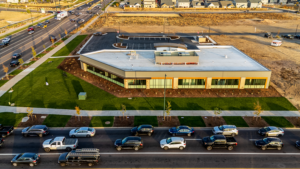By Fay Harvey
DENVER — Construction on UCHealth Green Valley Ranch Medical Center in the Gateway-Green Valley Ranch neighborhood of northeast Denver was recently completed. The state-of-the-art project was developed in partnership with Chicago-based Remedy Medical Properties and Los Angeles-based Kayne Anderson Real Estate, the nation’s largest private owners of healthcare real estate.
Early Phases
To address the rapid growth in the Green Valley Ranch area, UCHealth partnered with longtime collaborator Remedy in 2021 to identify a centrally located, highly visible site for a new health facility with room for future expansion. In 2022, a new site was identified, and the process of approvals and entitlements began. Despite the city’s permitting and review backlog following the Covid-19 pandemic, Remedy and UCHealth worked swiftly with the City of Denver and neighboring property owners to keep the project on track.
Once development began, construction moved quicker than the planning and approvals phase, which, according to Jim Moylan, executive vice president and managing director of design and construction at Remedy, is not typical.
Groundbreaking commenced in February 2024, and the building’s shell was completed in just eight months—allowing UCHealth to begin the interior fit-out of the one-story facility on schedule for its planned spring 2025 opening.
The project team also included Denver-based Davis Partnership Architects; the Greenwood Village, Colo., office of civil engineering firm Kimley-Horn; and local general contractor Howell Construction.
A Look Inside
The 12,170-square-foot medical office building sits on 1.18 acres near Peña Boulevard and the I-70 interchange, providing easy access for surrounding communities.

The building’s hexagonal shape provides healing views of Denver’s Front Range from the interior while simultaneously filling the space with an abundance of natural light. The building was oriented to be highly visible from the road, with an entryway that features a large sweeping archway to mirror the UCHealth logo.
“We went through several iterations before landing on the hexagonal design,” said Dave Martin, executive vice president and managing director of development at Remedy. “The building is on a unique site in that nearly every elevation is a prominent one and has setbacks along both streets that it’s fronting. The project team maximized the square footage allowed on the site while maintaining the required parking ratio.”
Inside, visitors are greeted by a shared lobby with a reception desk and a waiting area. Using wood slats and plants, waiting seats for primary care, urgent care, mammography and physical therapy services are thoughtfully separated.
For convenience, the imaging area is placed between urgent care and primary care rooms, while physical therapy is at the furthest point of the building alongside mammography. At the entrance of each clinic, a wood-wrapped soffit and pendant light fixtures add warmth and character. A central corridor connects all the spaces to ensure efficiency, with a breakroom at the center.
Construction materials were chosen for their successful implementation in other UCHealth building designs, creating a shared architectural language across the provider’s metro Denver facilities. Using brick, stone, gray paneling and wood creates there a strong sense of cohesion inside and out.“Wood-look flooring runs throughout, while the care team stations, and exam rooms are outfitted with a visually textured flooring,” said Deborah Willier, associate principal at Davis Partnership Architects. “Each care team station is designed with a glossy, textured panel on the front, complemented by quartz countertops and a warm wood ceiling with linear lighting overhead. Throughout the building you’ll find pops of green to pay homage to ‘Green’ Valley Ranch.”
The building is also futureproofed for eventual sustainable integrations, such as increasing the EV charging spaces from four to 10 and potentially adding solar panels to the roof.
“Everything here was focused on cost-effectiveness; there were no established sustainability goals beyond the governing International Energy Conservation Code (IECC),” said Moylan. “However, the design did include opportunities for green or sustainable elements to easily be added in the future.”
Looking Forward
As healthcare construction trends lean towards building bigger and bigger, Martin spoke to the benefit of offering more scaled spaces for healthcare delivery.
“More revenue is being generated in an ambulatory outpatient setting than in the inpatient setting,” he said. “And with the ever-rising cost of healthcare, and the ever-present desire to have the lowest possible cost of care, more care is moving to these freestanding ambulatory settings.”
Outpatient ambulatory settings that are housed in large buildings are proving to be more cost-effective than inpatient settings, Martin explained. But to Remedy, it is more about getting healthcare closer to patients and providers than monetary gains when pursuing projects.
“It’s all about the relationship for us,” Martin concluded. “Everyone wants to do big projects, but this was important to our client and so it was important to us as well.”
“We couldn’t be happier with the team we assembled to make this project a success,” Moylan added. “Thanks to our proactive development approach, the facility was delivered on time and on budget, allowing UCHealth to provide the community with a conveniently located, state-of-the-art outpatient destination for urgent care, primary care, imaging and physical therapy.”
In February, the facility also won the Health Care Real Estate Insights Award for Best New Medical Outpatient Building for projects of less than 25,000 square feet.


